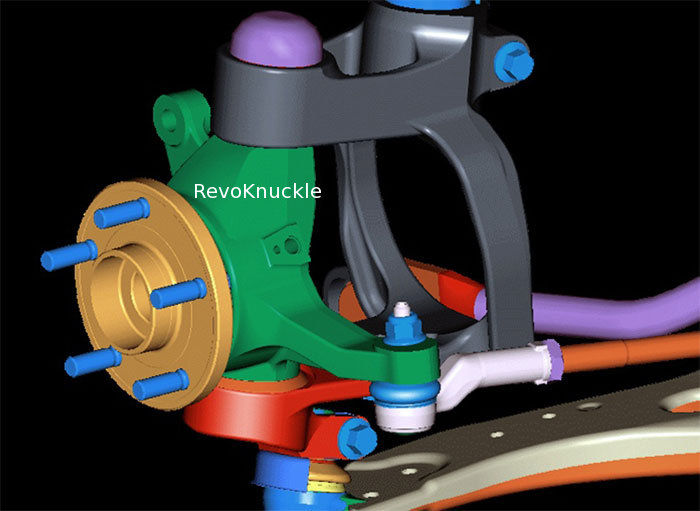TIL Ford uses what's called a SuperStrut, which they claim is the main reason the Focus ST doesn't have torque steer. The biggest change seems to be knuckle rotates independently of the strut. This design looks like a halfway point to the Multi-link design that G20's use.
Please note this thread is for discussing Super Struts vs Regular Struts only and their technical differences and advantages. I spun off another thread and moved all of the multi-link vs strut posts there: [url]www.sr20-forum.com/brakes-suspension/76918-multi-link-vs-super-strut.html[/url]
Car and Drive Source
 Originally Posted by Car
Originally Posted by Car
Ford’s RevoKnuckle and GM’s HiPer Strut both split the strut into two major components. The core spring-and-damper assembly [red] provides the up-and-down flexibility needed for a controlled ride over bumps. A new knuckle [green] attaches to the main assembly through pivot bearings to provide the steering movement. The GM version has a handy camber adjustment not included in Ford’s design.

Splitting the steering and suspension functions does wonders for front-end geometry. The steering axis (an imaginary line around which the knuckle pivots) is more vertically oriented and located closer to the tire’s centerline. This shortens the effective spindle length and moves the center of the tire contact patch nearer to the intersection of the steering axis and the ground, yielding a significantly smaller scrub radius [see diagram]. Since a long spindle and a large scrub radius are key contributors to torque steer, any reduction of these dimensions benefits steering feel and directional stability.
Another benefit is significantly reduced camber change (the tilt of the tire away from a vertical orientation) as the car is steered off-center. Keeping the tire more perpendicular to the road during turning is a boon to handling.
Please note this thread is for discussing Super Struts vs Regular Struts only and their technical differences and advantages. I spun off another thread and moved all of the multi-link vs strut posts there: [url]www.sr20-forum.com/brakes-suspension/76918-multi-link-vs-super-strut.html[/url]
Car and Drive Source
Ford’s RevoKnuckle and GM’s HiPer Strut both split the strut into two major components. The core spring-and-damper assembly [red] provides the up-and-down flexibility needed for a controlled ride over bumps. A new knuckle [green] attaches to the main assembly through pivot bearings to provide the steering movement. The GM version has a handy camber adjustment not included in Ford’s design.

Splitting the steering and suspension functions does wonders for front-end geometry. The steering axis (an imaginary line around which the knuckle pivots) is more vertically oriented and located closer to the tire’s centerline. This shortens the effective spindle length and moves the center of the tire contact patch nearer to the intersection of the steering axis and the ground, yielding a significantly smaller scrub radius [see diagram]. Since a long spindle and a large scrub radius are key contributors to torque steer, any reduction of these dimensions benefits steering feel and directional stability.
Another benefit is significantly reduced camber change (the tilt of the tire away from a vertical orientation) as the car is steered off-center. Keeping the tire more perpendicular to the road during turning is a boon to handling.
Last edited by Vadim
on 2015-02-09
at 17-12-38.


















 Back to top
Back to top
